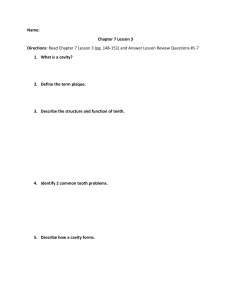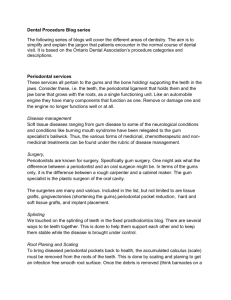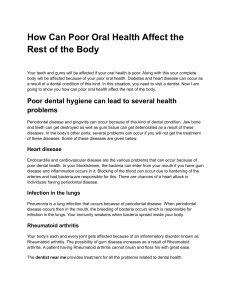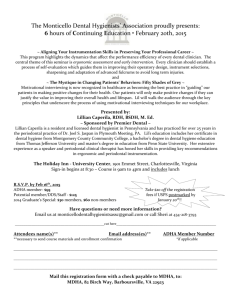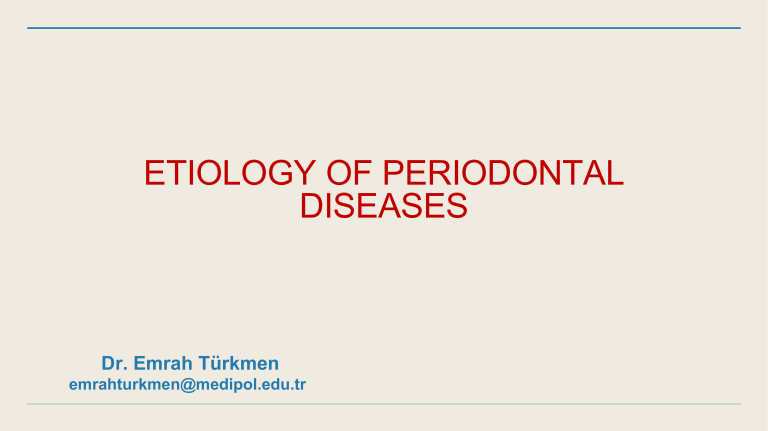
ETIOLOGY OF PERIODONTAL DISEASES Dr. Emrah Türkmen emrahturkmen@medipol.edu.tr The etiology of periodontal diseases includes: • Microbial factors • Accumulations on the Teeth • Malocclusions • Food impaction • Improper use of oral hygiene tools • Occlusal trauma • Bruxism • Iatrogenic factors • Chemical, Physical, Radial applications • Systemic factors • Various habits • Stress • Nutrition 1- Microbial Factors Microbial factors are the most important factor that plays a role in the etiology of periodontal diseases. 2- Accumulations on the Teeth • • • • • • Pellicle Materia alba Plaque Calculus Dental stains Food debris PellicIe: It is a homogeneous, membranous, cell-free film layer formed after tooth eruption. It is a structure composed of salivary glycoproteins and is observed between plaque and teeth. It is removed by polishing, but re-forms in a short time. Materia Alba: It is soft accumulation of microorganisms, desquamated epithelial cells, leukocytes, salivary proteins that the lack of organized structure of dental plaque It is somewhat less adherent than dental plaque. Easily displaced with a water sprey Plaque: It is a mass firmly adhered to the tooth, consisting of microorganisms, leukocytes, desquamated epithelial cells, salivary glycoproteins. Impossible to remove by rinsing or the use of sprays Calculus: Hard deposits that forms mineralization of dental plaque Generally covered by a layer of unmineralized plaque Dental Stains: Pigmented deposits on the tooth surface are called dental stains. Stains are primarily an aesthetic problem and do not cause inflammation of the gingiva The use of tobacco products, coffee, tea, mouthrinses, and pigments in foods can contribute to stain formation Food Debris: Most food debris is rapidly liquefied by bacterial enzymes and cleared from the oral cavity by salivary flow and the mechanical action of the tongue, cheeks, and lips Dental plaque is not a derivative of food debris, and food debris is not an important cause of gingivitis. 3- Malocclusions The irregular alignment of teeth may make plaque control more difficult Marginal and papillary gingivitis is frequently encountered in the maxillary anterior sextant in cases that involve an anterior open bite with mouth breathing. 4- Food Impaction It is forceful wedging of food into the periodontium by occlusal forces. Hirschfeld classification of factors causing food impaction: 1- Occlusal wear 2- Loss of proximal contact 3- Extrusion beyond the occlusal plane 4- Congenital morphological abnormalites 5- Improperly constructed restorations 5- Improper use of oral hygiene tools Abrasions of the gingiva as well as alterations in tooth structure may result from aggressive brushing in a horizontal or rotary fashion. The gingival changes that are attributable to toothbrush trauma may be acute or chronic. The acute changes vary with regard to their appearance and duration, from scuffing of the epithelial surface to denudation of the underlying connective tissue with the formation of a painful gingival ulcer. Chronic toothbrush trauma results in gingival recession with exposure of the root surface. • The improper use of dental floss may result in lacerations of the interdental papilla 6- Occlusal Trauma It is refers to injury to the periodontium caused by excessive occlusal forces. More force comes into the periodontium than it can tolerate The most common clinical findings are widening of periodontal ligament space and increased mobility. 7- Bruxism Bruxism is a movement disorder characterized by grinding and clenching of teeth. It has devastating effects on teeth, soft tissues and alveolar bone. Periodontal destruction is inevitable in teeth that have lost periodontal support. 8- Iatrogenic Factors Inadequate dental procedures that contribute to the deterioration of the periodontal tissues are referred to as iatrogenic factors. Overfilled fillings Destruction of the gingiva by fillings and crowns Destruction by various filling materials and tools Destruction caused by faulty planning of partial dentures Complications during orthodontic treatment Destruction of bone and gingiva while teeth are being extracted 9- Chemical, Physical, Radial Applications Pressing aspirin, cologne or alcohol on the gums Side effects of various drugs (alendronate, nifedipine, dilantin, overused mouthwashes) Consumption of excessive hot food/liquid Matrices bands used in dental fillings Effects of radiotherapy and chemotherapy (mucositis, osteoradionecrosis) Aspirin burn 10- Systemic Factors Hormonal, puberty, pregnancy, menopause, Various hematological problems, Various sytemic diseases and drugs used in their treatment 11- Various Habits Occupational habits: Shoemakers with taking nails in their mouths, tailors tearing threads with teeth, acrobats lifting weights with their teeth etc. Personal habits: Tongue and lip piercing, nail biting, pen biting etc Tongue piercing 12- Stress It can increase susceptibility to periodontal disease by weakening the immune system. The most typical example is acute necrotizing ulcerative gingivitis.(ANUG). 13-Nutrition Proteins, carbohydrates, vitamins, minerals and lipids, the frequency and timing of the daily diet play an important role in susceptibility to periodontal disease. Scurvy, which develops due to vitamin C deficiency, is the most typical example.
